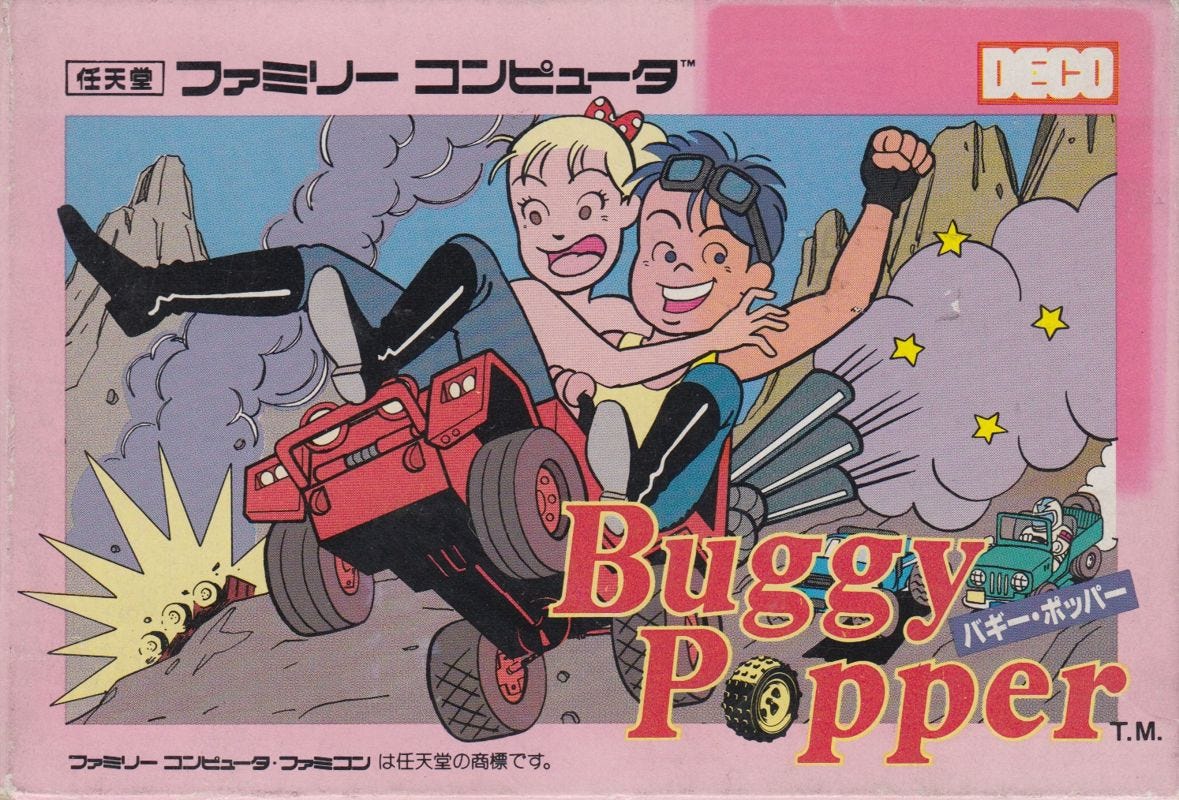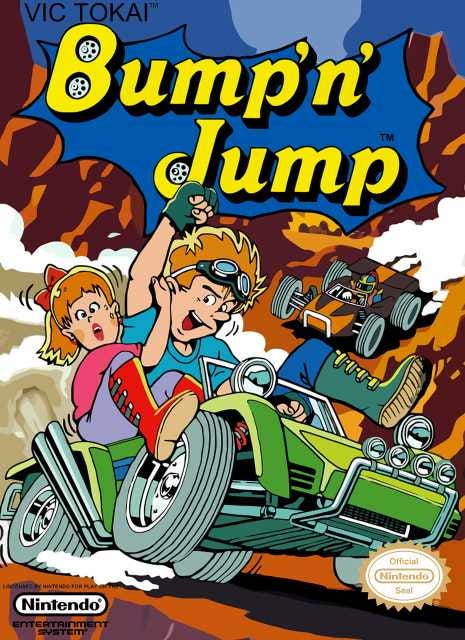This column is “It’s new to me,” in which I’ll play a game I’ve never played before — of which there are still many despite my habits — and then write up my thoughts on the title, hopefully while doing existing fans justice. Previous entries in this series can be found through this link.
Data East was all over the spectrum of arcade genres in the 80s. They were behind the Magical Drop series of puzzle games, as well as platformers like Burger Time and various shoot ‘em ups, beat ‘em ups, and run-and-guns. They also had their more one-off ideas, like 1982’s arcade release, Burnin’ Rubber: an overhead vehicular combat game, which became a popular genre that decade. Burnin’ Rubber was such an early entry in the genre that the Wikipedia page “List of vehicular combat games” doesn’t actually include it (remember, kids, it’s merely a resource, not gospel), and instead begins with 1984’s Spy Hunter… which was developed and published by Bally Midway after the company had already brought Burnin’ Rubber to North America, where it would be known as Bump ‘n’ Jump.
Burnin’ Rubber is a pretty generic name, as far as these things go. Bump ‘n’ Jump, though, now that’s a name that tells you what you’re about to spend your time doing. It’s actually such a perfect description that it’s surprising the naming conventions aren’t flipped, with the generic one coming out of North America as a replacement for the truth in advertising that was Japan’s name. Here’s Bump ‘n’ Jump at its simplest: you bump into cars to send them to their doom so they can’t bump into you first, and you jump over obstacles to avoid crashes and onto other vehicles to destroy them, too. Bump, and jump. Bump ‘n’ Jump!
There’s nothing in particular that’s wrong with the original arcade edition of Bump ‘n’ Jump/Burnin’ Rubber (outside of the miss on the name). It’s a tough game, though, as it’s very unforgiving when you do bump into another car, especially if said car has bumped into you instead of the other way around. You’ll go flying off into the guardrails and explode, or just go right off the unprotected edge and fall to your doom. There’s some joy in its relative simplicity, but some tweaks would have made it a better game, too. Which is where the NES port comes into play.
Burnin’ Rubber first released in Japanese arcades in 1982. It was then ported to the Intellivision and Atari 2600 in 1983, with a Colevision edition in 1984. These versions, all developed and published by companies that weren’t Data East such as Mattel Electronics, made some minor tweaks — you can continue in the Atari 2600 version from the stage you ran out of lives in, for instance — but they were essentially the same game as the original. In 1986, however, Data East themselves went back to Burnin’ Rubber for a Famicom release, which was meant to be something of a pseudo-sequel and the definitive edition of the game. Here, bumping into other cars has been tweaked so that the general balance is a little fairer and you aren’t guaranteed to fly off and die every time you’re touched, and gas was introduced, too. Having to monitor fuel levels and pick up additional gas changes the game a bit, because you already had quite a bit going on for such a simple premise, and now there was one more thing to consider.
Because of these changes, the best version of Bump ‘n’ Jump just isn’t available these days. You can buy Burnin’ Rubber through Arcade Archives on the Nintendo Switch or Playstation 4, but that’s all. That’s a positive, that it exists out there for you to experience in a legal fashion, but when you know of and have experienced the superior edition… well, it’s tough to go back.
There are two ways to score the points you need to get through a Bump ‘n’ Jump run. One: bumping and jumping. You score points for destroying the small cars and for the larger trucks that can’t be bumped, but must be jumped on. You also get per-car bonus points at the end of each of the game’s stages, so being exceptionally destructive is a good way to grab an extend at 30,000 points. There’s a second way to score points, however, and it’s the opposite of the first: don’t destroy anything. If you manage to clear an entire stage without destroying a single car or truck, you’ll get a 50,000-point bonus at the end of the level. That’s an extend and then another 20,000 points toward your next one. It’s also a real challenge, because you don’t even have to bump a car directly in order to destroy it: if one swerves out of your way and into a guardrail, or pinballs into another car that then launches into the barriers and explodes, well, that’s on you. And avoiding ever bumping into any car is rough, since they tend to cluster around you, while those trucks are there to drive slow and drop various obstacles in front of you. The temptation and/or instinct to destroy before you’re destroyed is going to be strong.
Those obstacles, by the way, are determined by what color the truck is. Red ones will spill oil, green trucks loose boulders on the road, while blue drops cement. There are also bulldozers, which don’t drop anything, but are bulldozers, so they can certainly get in your way. Even if you’re going the destruction route for your points, you might want to wait and see what trucks drop before you jump on top of them, as they occasionally drop an extra life pickup instead of whatever obstacle you thought you were going to have to dodge.
These are also not the only obstacles you’ll deal with. Sometimes the cars aren’t even the most pressing issue at hand, but their presence makes the tracks themselves that much tougher to navigate. Each course has a kind of obstacle to overcome, which you’ll get a warning for in the form of an exclamation point on-screen. In the first stage, for instance, the roads suddenly go away, and you need to time your jumps to cross from the stretch of road you’re on to another in front of you, while also course-correcting in midair when the new stretch of road isn’t where you thought it was going to be. The second stage puts up these giant brick walls that you have to leap over so you don’t crash into them, and the timing aspect is still vital here, lest you land on the side of the wall instead of clearing it. Avoid cars all you want, but if you keep falling into holes in the road or slamming into brick walls at 240 km/h, you’re going to run out of lives in a hurry.
The roads themselves are often narrow, and their sides often not straight, but instead aggressively angled just to increase the chances that you get stuck in some kind of pinballing death trap. Bump ‘n’ Jump seems easy enough at times, but then the road narrows, an obstacle warning flashes in front of you, and half-a-dozen other cars attempt to kill you at once. You’ll also potentially kill yourself just by making the wrong jump and spinning out of control on the landing, and everything becomes tougher when you’re trying to avoid bumping into cars at all, of course.
The gas aspect changes things for the better and the more complicated more than you might think, too. You begin with 100 units of fuel in each stage, and it quickly depletes. Gas cans, labeled with a P, are strewn throughout the course, and while they’re plentiful, they also aren’t placed in safe places. In fact, their placement sometimes seems a bit random, and if it’s not random, the idea is certainly to purposefully cause you to make bad decisions. Sometimes the gas cans are on obstacles themselves, which, you know, would kill you if you collected it. Luckily, you don’t need every gas can you find in order to make it to the end, which makes picking the right gas cans, and avoiding blowing yourself up somehow trying to get the wrong ones, a great way to add depth and make Bump ‘n’ Jump feel more dynamic on the NES than it did in arcades and its other home ports.

There are 16 stages in Bump ‘n’ Jump, and the thing you’re going to need to do is remember how the stages work, as they end up repeating (but tougher). The first three don’t repeat, and instead serve to teach you the ropes of the game. After that, though, you’ll see multiple versions of stage 4, stage 5, etc. as you go, with the major change in stage 9 — the start of the first looped series of stages — being that the trucks can now drop two loads of obstacles instead of just one. Pretty typical arcade setup from the time, really: loops were common, as was a stage a lot like a stage you already played, only more difficult showing up. The Famicom edition might have released in 1986, but that’s not that long after the idea of an actual ending was introduced to video games, and it’s based on an arcade game from 1982, so. Get through those 16 stages to get more of an “ending” than an ending, then you can play those 16 on another, more difficult loop.
That ending, by the way, involves rescuing your kidnapped girlfriend, though this is just in the Famicom/NES edition. The only time you really see her is when the game begins, and another car drives off while a speech bubble containing “Help me!” floats alongside of it. That one speech bubble isn’t much motivation for driving around blowing up the cars around you, but it’s more than the for-the-hell-of-it approach of the arcade edition had.
It would be appreciated if Bump ‘n’ Jump, at the least, made it to Nintendo Switch Online, so that the opportunity was there for people to play the superior version of the game. Burnin’ Rubber hit Arcade Archives way back in September of 2020, however, so it doesn’t seem like there’s any urgency to make even that happen, never mind to put the NES edition on sale anywhere. It’s not an all-timer, by any means, but it’s still an enjoyable and challenging game, and one where it’s easy to see why the genre ended up flourishing shortly after, and why Data East went back after a few years to spruce it up to get it to that point.
This newsletter is free for anyone to read, but if you’d like to support my ability to continue writing, you can become a Patreon supporter, or donate to my Ko-fi to fund future game coverage at Retro XP.





That's frustrating with the superior version not being available.